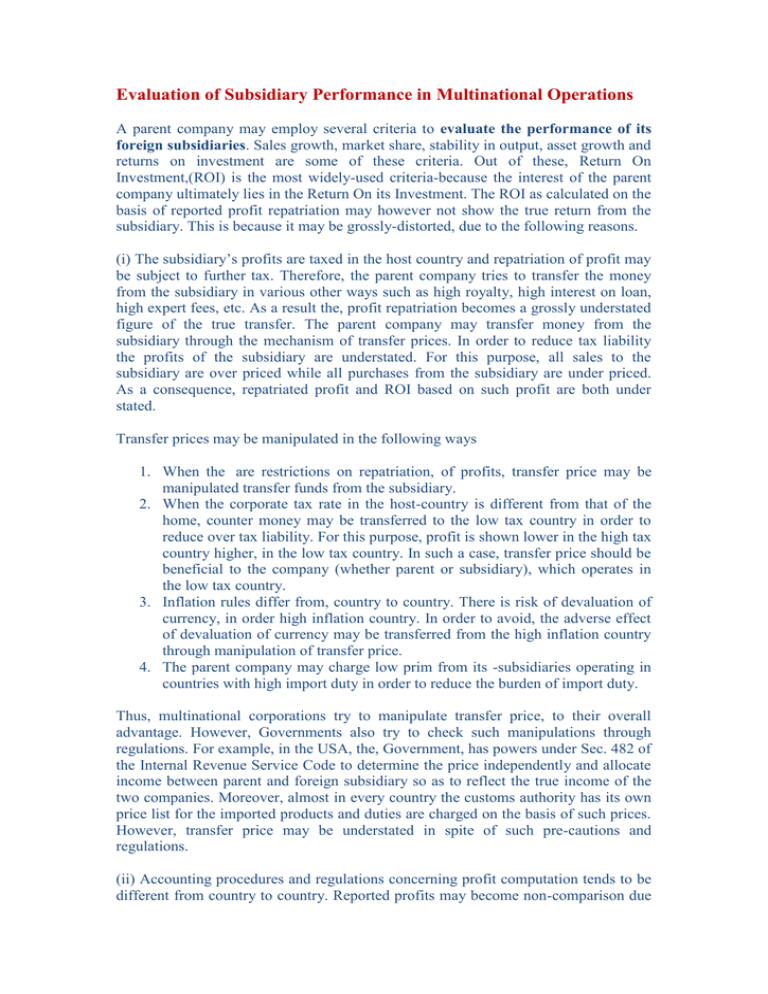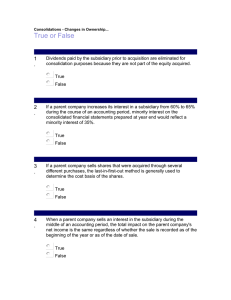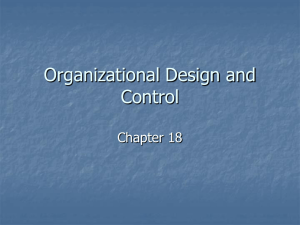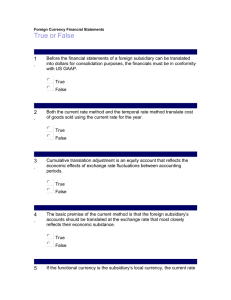Evaluation of Subsidiary Performance in Multinational Operations
advertisement

Evaluation of Subsidiary Performance in Multinational Operations A parent company may employ several criteria to evaluate the performance of its foreign subsidiaries. Sales growth, market share, stability in output, asset growth and returns on investment are some of these criteria. Out of these, Return On Investment,(ROI) is the most widely-used criteria-because the interest of the parent company ultimately lies in the Return On its Investment. The ROI as calculated on the basis of reported profit repatriation may however not show the true return from the subsidiary. This is because it may be grossly-distorted, due to the following reasons. (i) The subsidiary’s profits are taxed in the host country and repatriation of profit may be subject to further tax. Therefore, the parent company tries to transfer the money from the subsidiary in various other ways such as high royalty, high interest on loan, high expert fees, etc. As a result the, profit repatriation becomes a grossly understated figure of the true transfer. The parent company may transfer money from the subsidiary through the mechanism of transfer prices. In order to reduce tax liability the profits of the subsidiary are understated. For this purpose, all sales to the subsidiary are over priced while all purchases from the subsidiary are under priced. As a consequence, repatriated profit and ROI based on such profit are both under stated. Transfer prices may be manipulated in the following ways 1. When the are restrictions on repatriation, of profits, transfer price may be manipulated transfer funds from the subsidiary. 2. When the corporate tax rate in the host-country is different from that of the home, counter money may be transferred to the low tax country in order to reduce over tax liability. For this purpose, profit is shown lower in the high tax country higher, in the low tax country. In such a case, transfer price should be beneficial to the company (whether parent or subsidiary), which operates in the low tax country. 3. Inflation rules differ from, country to country. There is risk of devaluation of currency, in order high inflation country. In order to avoid, the adverse effect of devaluation of currency may be transferred from the high inflation country through manipulation of transfer price. 4. The parent company may charge low prim from its -subsidiaries operating in countries with high import duty in order to reduce the burden of import duty. Thus, multinational corporations try to manipulate transfer price, to their overall advantage. However, Governments also try to check such manipulations through regulations. For example, in the USA, the, Government, has powers under Sec. 482 of the Internal Revenue Service Code to determine the price independently and allocate income between parent and foreign subsidiary so as to reflect the true income of the two companies. Moreover, almost in every country the customs authority has its own price list for the imported products and duties are charged on the basis of such prices. However, transfer price may be understated in spite of such pre-cautions and regulations. (ii) Accounting procedures and regulations concerning profit computation tends to be different from country to country. Reported profits may become non-comparison due to differences in methods of inventory valuation, depreciation, vestment allowance etc. However this issue becomes important only when comparisons between two subsidiaries operating in different countries are made. (iii) The parent company is interested in net repatriated profit (representing the true net flow) rather then in gross repatriated profit. The two figures differ due to host country tax on repatriation, withholding taxes, and home country tax on receipt of foreign profit. In order to calculate the act repatriated profit these items must be deducted from the gross repatriated profit. Credit: Management Control Systems-MGU MBA - Knowledge base





